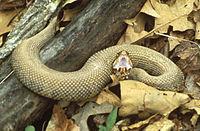Agkistrodon piscivorus conanti: Difference between revisions
imported>Jaap Winius m (Florida Cottonmouth moved to Agkistrodon piscivorus conanti: Scientific names should be used for page names on biological organisms whenever possible to avoid confusion.) |
imported>Aleksander Stos m (WP credit, added wgrp, red category cleanup) |
||
| Line 36: | Line 36: | ||
*[http://www.calusanature.com Calusa Nature: Florida Cottonmouth] | *[http://www.calusanature.com Calusa Nature: Florida Cottonmouth] | ||
[[Category: | [[Category:Biology Workgroup]] | ||
Revision as of 13:57, 30 March 2007
| Florida Cottonmouth | ||||||||||||||||||||||
|---|---|---|---|---|---|---|---|---|---|---|---|---|---|---|---|---|---|---|---|---|---|---|
 | ||||||||||||||||||||||
| Scientific classification | ||||||||||||||||||||||
| ||||||||||||||||||||||
| Trinomial name | ||||||||||||||||||||||
| Agkistrodon piscivorus conanti Gloyd, 1969 |
The Florida Cottonmouth (Agkistrodon piscivorus conanti) is one of three subspecies of the cottonmouth, (Agkistrodon piscivorus) that is found east of the Mississippi River. The epithet conanti is in honor of American herpetologist Roger Conant.[1]
Geographic range and habitat
The Florida Cottonmouth is commonly found in Florida, southeastern Alabama and southern Georgia. Its preferred habitats are pine flatwoods, ponds and stagnant streams, as well as brackish water habitats, such as estuaries.
Size and appearance
Adult snakes average 36 inches in length, however, individuals measuring up to six feet in length have been documented. Compared to other snakes of similar length, the Florida Cottonmouth is heavy bodied. Like most pit vipers, the snake's head is triangular in shape, and thicker than the neck. Juveniles have alternating bands of yellow and brown, making them appear somewhat similar to copperheads (Agkistrodon contortrix). Adults lose the bands upon reaching maturity and develop a dark, muddy-brown hue with faint brown stripes circling the body.
Diet and behavior
As with all snakes, the Florida Cottonmouth is a carnivore, consuming small mammals, birds, fish, as well as reptiles. The Florida Cottonmouth first incapacitates its prey with a dose of its hemotoxic venom, before ingesting it whole. Young cottonmouths are known to use their bright yellow tail as a lure to entice frogs to move within striking range.
Reproduction
The Florida Cottonmouth is ovoviviparous and while it has no specific mating season, most births occur in summer. Females generally only breed every other year and give birth to between one and 15 young per litter. Newly born snakes average 7 inches in length.